While you may not be chomping at the bit to go hiking in the rain, knowing how to stay dry and comfortable in bad weather is an important trail skill. You never know when you might get caught in a storm.
Or, maybe, you choose to go hiking in the rain! A few years ago, Ryan and I were up in Stanley, Idaho and the forecast called for rain our entire trip. Embracing the wet weather was our only option unless we wanted to be stuck inside our van for a week straight. So, we geared up in our rain gear and hit the trails!
Or there was the time when I organized a group backpacking trip to Alaska and the weather was less than stellar. Without the right preparation (and attitude), it could have been a miserable experience. Instead, our group took the necessary measures to stay dry and we had a blast and came home with a newfound love and confidence for rainy-day hiking.
In this guide, I share tips for hiking in the rain that will help you embrace your time outdoors, no matter the weather. You’ll be pleasantly surprised that with the right rain gear and the expert tips found below, you can get outside and have fun even on the wettest of days.
Sponsored by REI Co-op
REI Co-op is our favorite outdoor gear retailer and a long-time supporter of our work here at Bearfoot Theory. We appreciate their 1-year return policy, their Member-only coupons, and the fact that REI Members receive 10% back on their purchases every year. We only recommend products we truly love and think you will love too.
Basic Tips for Hiking in the Rain
Hiking in the rain requires a little extra preparation than a sunny day hike because you need to take extra safety precautions to prepare for the harsh elements. Here are some basic tips for getting started with hiking in the rain.
1. Choose the right trail
Skip the views
Choosing which trail or area to hike is the first step in having a successful wet-weather adventure. On rainy days, you won’t be able to see expansive views, so a summit hike isn’t your best bet (especially if there’s a risk of lightning).
Instead, explore a trail through the forest, alongside a river, to a waterfall, or to a lake. These trails are great on wet days because they usually don’t feature big viewpoints, so you won’t feel like you are missing out.

Choose a hike where expansive views aren’t the main attraction
Choose a goal
You should also consider what you want to get out of your rainy day hike. For example, are you looking for exercise or relaxation? Are you going alone or with friends? What your goals are will help determine where you should go.
- If you’re seeking exercise and it’s super wet outside, it’s smart to hit a trail that isn’t overly steep or rocky so you can hike without too much risk of slipping.
- If you’re hoping to relax, I suggest choosing a trail that meanders through a forest so you can enjoy the relaxing rain sounds.
Whatever you choose, pick a shorter trail that can be completed within a few hours or half a day. That way, if the weather turns south you’re not too far from the trailhead.
Do your research
On that note, it’s good practice to read up on the specific trail before heading out. This is important because if the views are skewed, you want to make sure you have your bearings, so you don’t get lost.
If it’s super steep, or there are creeks to ford, or if it’s prone to flooding, it’s probably best to save it for a dry day. The same goes for thunderstorms.
Download my FREE Outdoor Trip Planning Toolkit
Enter your email to get access to printable PDF packing checklists, itineraries, and more.
2. Check the weather – and don’t go out if there’s lightning
If there’s lightning, it’s not safe to be outside. So check the weather before you head out for your hike to see if thunderstorms are to be expected. If they are, take a raincheck or wait to see if the weather clears up in a few hours.
If you do find yourself out in the middle of a storm with lightning, you don’t want to be exposed on any ridges, peaks, or open areas. Basically, you don’t want to be the tallest thing in your vicinity since lightning is attracted to tall objects.
Ideally, you want to go straight back to your car, but if that’s not possible, you’ll want to head down into the forest and position yourself away from the biggest trees.
Get rid of your trekking poles and any other metal objects and crouch down with the balls of your feet flat on the ground.
3. Pack a communication device
For an added safety measure, consider carrying a satellite communicator like the Garmin inReach Mini 2 Satellite Communicator or the Zoelo. These small handheld devices have 2-way texting, SOS, and location sharing. If you plan to hike in an area with spotty cell service, a GPS device could be a life-saving piece of equipment in an emergency.
Ideally, you want to attach your communication device to the outside of your pack for easy access. Both of these devices are also waterproof so you don’t have to worry about them getting wet.
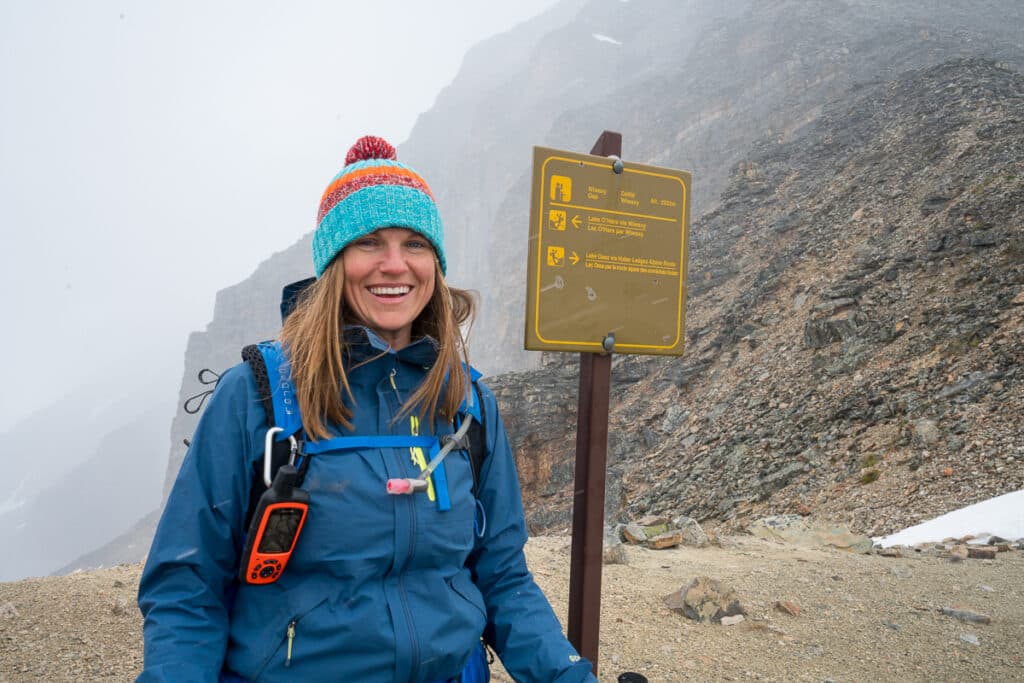
I hike with a communication device strapped to my backpack
4. Pack easy snacks to eat on-the-go
If it’s pouring, the last thing you’ll want to do is stop and eat a sandwich or something that requires preparation on the trail for lunch. Not only is this inconvenient, but when you stop moving, you lose body heat.
Since you likely won’t stop long for a snack break like you would on a sunny day, it’s best to pack easy snacks you can eat on the move. Here are a few of our favorite easy and healthy hiking snack ideas:
As always, please remember the Leave No Trace guidelines and pack out all snack materials (including nut shells, fruit peels, etc.).
5. Cautiously cross creeks and streams
When hiking in the rain, cross streams one mindful step at a time and be careful of slippery rock hazards. Generally, fine gravel is going to provide better traction than big stones when it’s wet.
Before you cross a stream, always unbuckle your pack, especially if it’s heavy. This extra step will prevent you from getting weighed down in the water if you happen to fall.
As you cross, you want to face upstream, keep your feet waist distance apart, and make sure you have solid footing before you take another step.
If you have trekking poles, they can be used to measure water depth and they can also be used to provide additional balance.
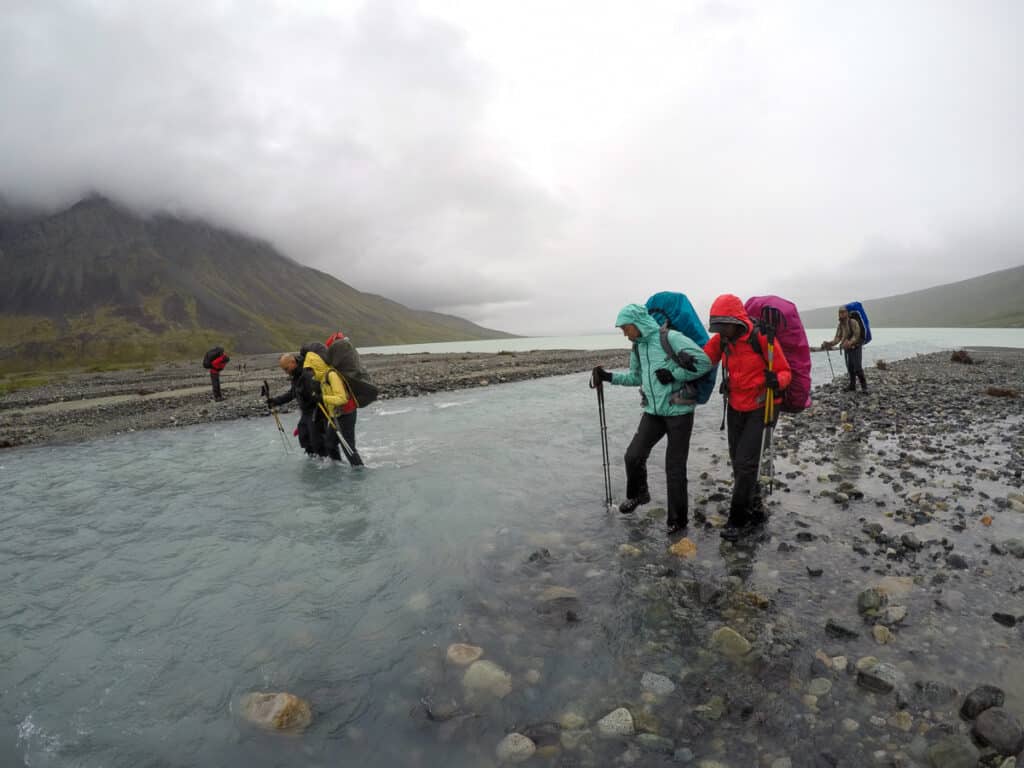
Crossing streams in pairs (while crossing arms) is a good technique for improving your stability
Important: Crossing deep rivers can be dangerous, especially if it has been raining a lot. Avoid fast-moving water and make sure you know how deep the river is before attempting a crossing.
6. Pack towels and extra clothes in your car
If you know you’re going to be hiking in wet conditions, a dry towel and a pair of clothes will be just what your body craves after a rainy hike. Towels are also handy if you are hiking with dogs.
What to Wear Hiking in the Rain
If you plan on hiking in the fall or spring when the weather is especially unpredictable, having quality rain clothing is key. Good hiking rain clothing requires a balance between keeping you dry and warm but cool enough so that you’re not getting sweaty. Below are some tips for what to look for, plus my top apparel picks.
7. Wear a durable rain jacket
Investing in a high-quality, durable rain jacket that can withstand harsh conditions means you’ll be more likely to get outside on those rainy days. You’ll want a fully waterproof jacket (not water-resistant) with an adjustable hood.
Rain jackets themselves aren’t that breathable, so I’m a big fan of rain jackets with armpit zips. These vents make a significant difference in my comfort level and allow me to hike in the rain without getting too sweaty.
When it comes to fit, you want a rain jacket that has enough room to layer underneath on colder days.
Below are two great rain jackets. If you want more recommendations, see my blog post on the best rain jackets for hiking.
REI Co-op Rainer Rain Jacket
The Rainier Rain Jacket (men’s) is a best-selling lightweight, budget-friendly rain jacket. It’s designed with pit zips, fully taped seams, a durable water-repellent (DWR) finish, and an adjustable hood – basically everything you need to stay dry on a rainy day hike.
Arc’teryx Beta AR Rain Jacket
If you live in a wet, cold climate or have a backpacking trip where inclement weather is a major concern, the Arc’teryx Beta AR jacket is an awesome choice. This is what I brought to Alaska on a 10-day backpacking trip, and it performed beautifully.
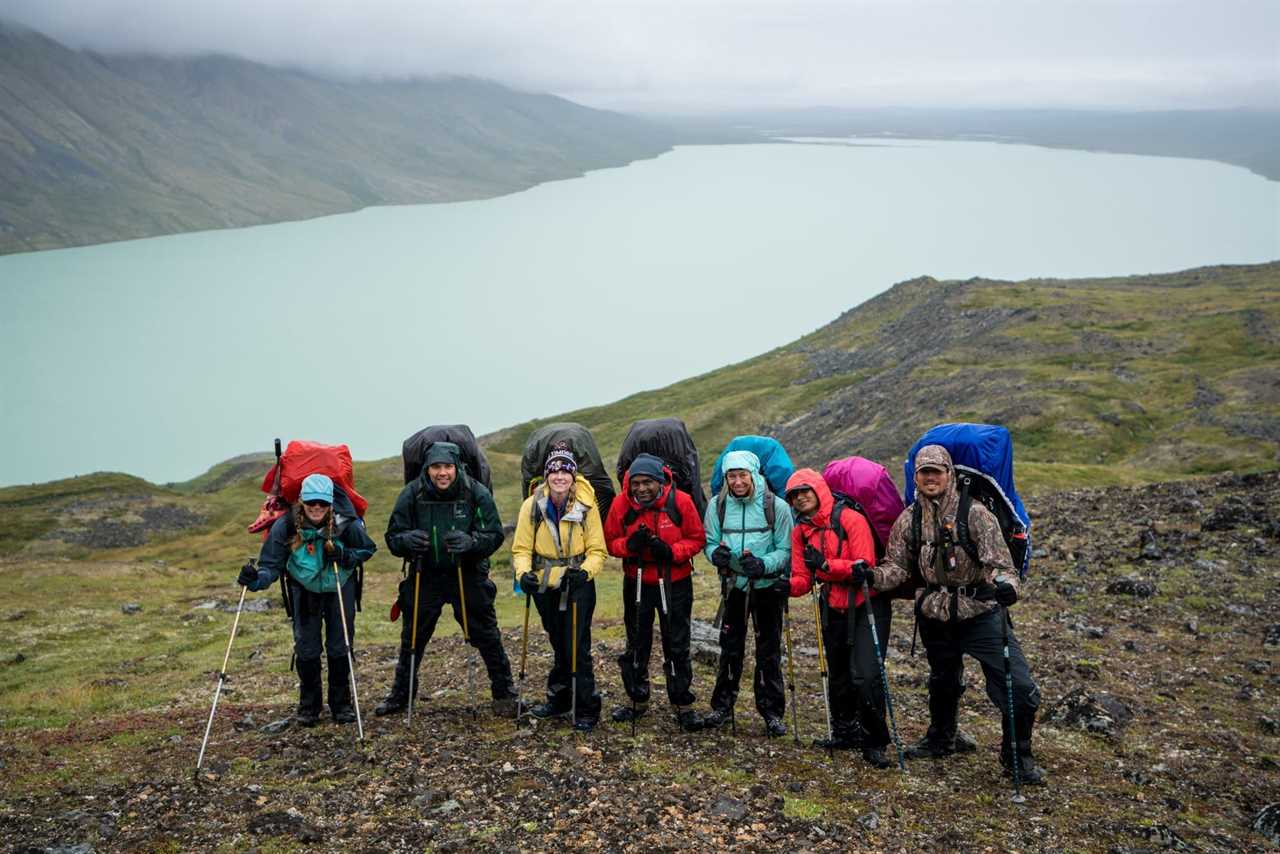
Having waterproof gear makes all the difference when hiking in the rain
8. Avoid cotton and down
Both cotton and down stay damp and heavy and lose their insulating properties when wet. Instead, stick with synthetics and natural fibers (like wool) that are lightweight, breathable, and wick water away from you.
Underneath my rain jacket, I usually wear my long-sleeve Patagonia cool capilene shirt. It is quick-drying, moisture-wicking, and highly breathable.

My long-sleeve Patagonia Capilene shirt is my go-to for rainy-day hikes
9. Pick items with good ventilation
Waterproof fabrics aren’t very breathable, so look for gear that has pit zips, leg zips, and other ways to get easy airflow to regulate your body temperature. These zips are usually subtle, but they are game-changers when it comes to breathability and comfort.
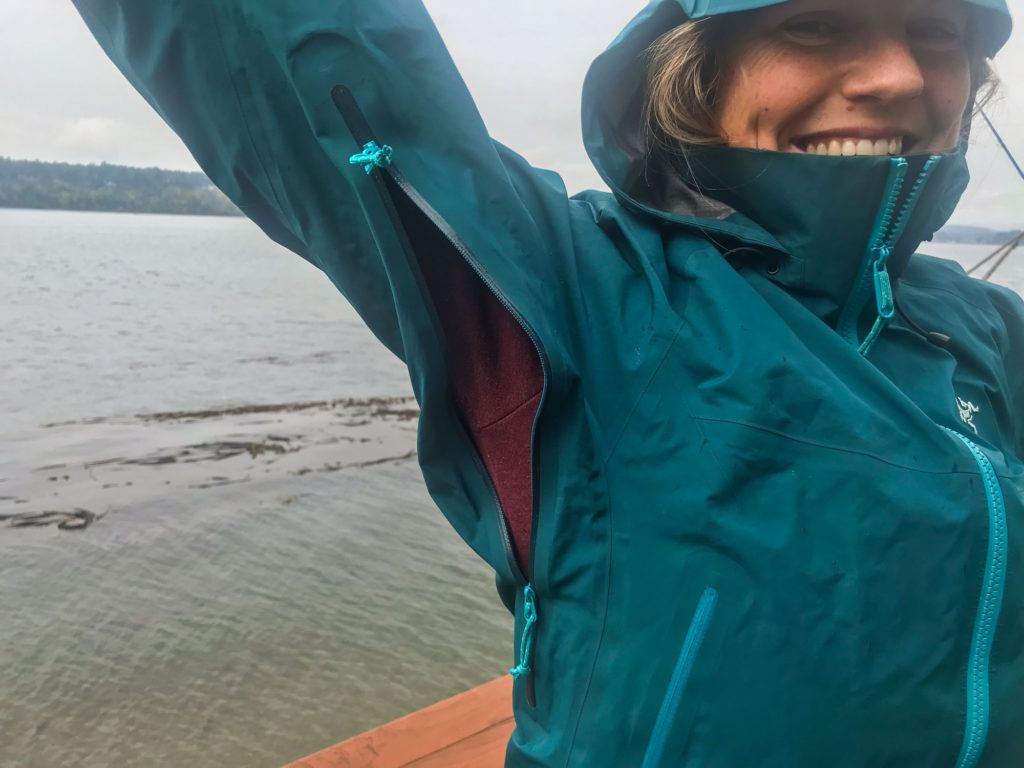
Pit zips are an absolute must for maintaining comfort in a rain jacket!
10. Wear a hat with a brim
Wearing a baseball-style or trucker hat helps keep water out of your eyes and off your face and can easily be worn under a hood. Alternatively, you can get a hat that is specifically designed for wet weather like the REI Sahara Rain Hat, which features a 360-degree brim and is fully waterproof.

Brimmed hats help keet the rain off your face and out of your eyes
11. Wear wool socks
Regardless of the weather, I recommend wearing wool socks when you hike. But in rainy weather, wool socks (compared to cotton) will keep your feet drier for longer and will help prevent blisters.
I love Darn Tough Socks. They are cushioned in all the right places and are “buy it for life.” I wore them for over 22 days on the John Muir Trail, and I didn’t form a single blister.
Glasses get foggy in the rain, so contacts can be a better option to avoid dealing with water droplets smearing your vision. And again, wearing a hat with a brim will help water stay out of your eyes or glassware.
13. Wear waterproof hiking pants
You should wear (or throw in your pack) a pair of rain pants designed for hiking that are comfortable, breathable, and waterproof (not water-resistant). I also look for rain pants that have a zipper at the bottom so I can get them on and off without taking my shoes off.
I suggest wearing leggings or other light pants underneath so that you can take the rain pants off if it stops raining.
Some people choose not to wear waterproof pants when hiking in the rain, but if it’s a really wet day you might end up with some inner thigh chafing and that’s no fun.
REI Rainier Rain Pants
The REI Co-op Rainier Rain Pants (men’s) are great to toss in your bag just in case. They have zippered leg vents that allow you to easily take them on/off without having to remove your boots.
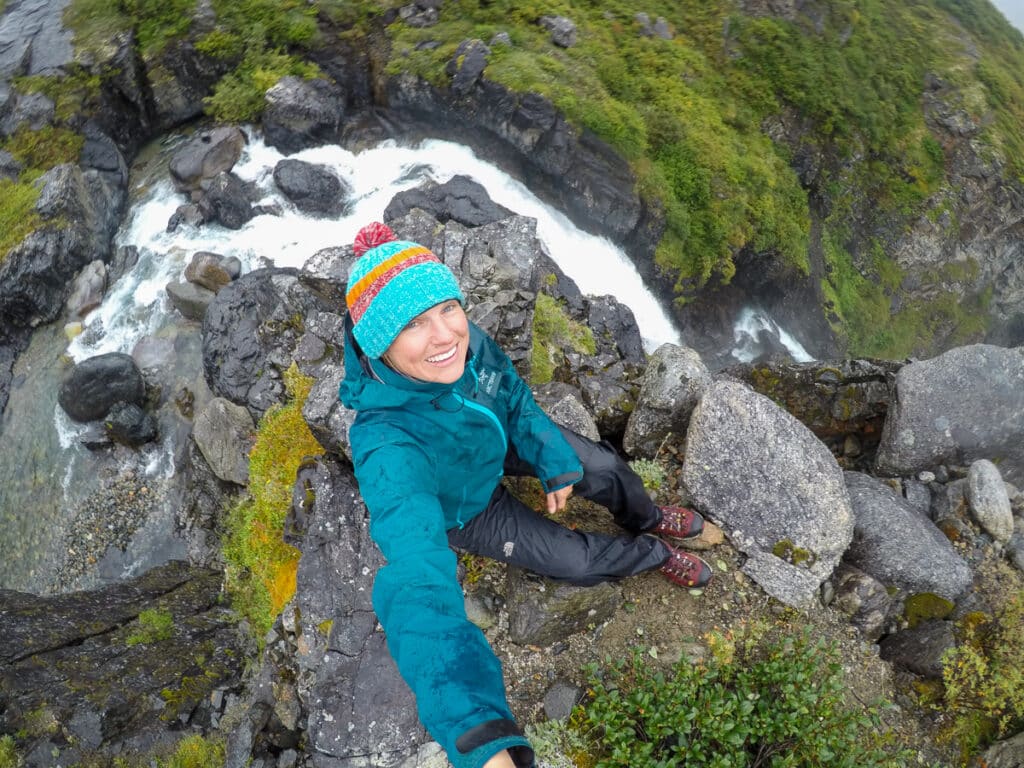
Waterproof pants make hiking in the rain more comfortable and allow you to embrace the elements!
14. Wear Waterproof Hiking Shoes
It’s a major letdown when you have to turn around because your feet are soggy. So, one of the keys to a successful hike in the rain is solid waterproof hiking footwear.
When hiking in wet conditions, I opt for a higher ankle boot like the Oboz Bridger Mid or the Oboz Sypes Mid. These provide more ankle support on slippery trails and keep water out better than a low-ankle shoe (especially when paired with gaiters).
If you already have hiking boots, there’s a good chance that they are waterproof, so double-check before running out to buy a new pair for hiking in the rain.
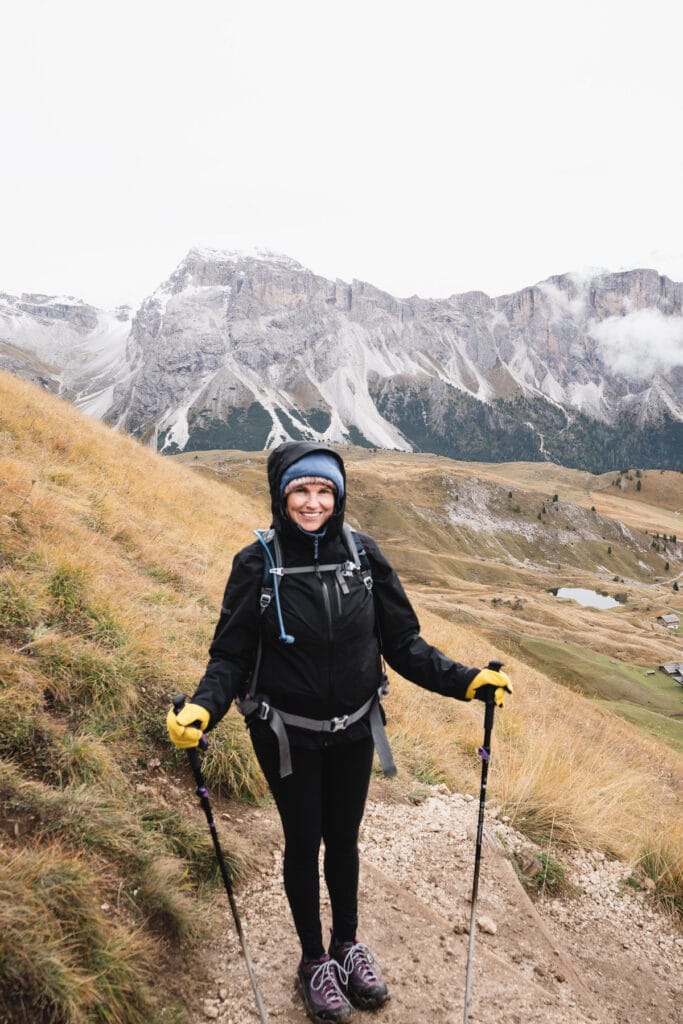
Make sure to wear waterproof hiking boots on rainy days, otherwise your feet will get cold
15. Bring neoprene gloves
A trick I learned from my backpacking guide in Alaska is that the best way to keep your hands warm while hiking in the rain is to wear neoprene gloves. While they won’t keep your hands dry, neoprene insulates when wet, so your fingers will stay nice and toasty as you hike.
16. Pack gaiters
If you’ll be hiking through mud or deep puddles, gaiters will keep mud and water from splashing into your shoes beneath your pants.
REI Backpacker Low Gaiters
The REI Co-op Backpacker Low Gaiters are great because they’re adjustable and they have hooks at the bottoms to ensure a secure fit around my shoes.
17. Use hand warmers
Hand warmers are little pockets of joy on rainy cold days. They’re not going to help you stay dry, but they can be effective and cozy mood boosters. I like to put them inside my gloves or pants pockets.
Gear to Pack for a Rainy Day Hike
You may have heard the saying, “There’s no such thing as bad weather, just bad gear.” While there is some truth to this, there’s also not-good weather. But, we’ll focus on the gear because that’s the thing we have control over. These are essentials that you’ll be happy to have on hand when storm clouds appear.
18. Bust out your trekking poles
Trekking poles are great on any kind of trail, rain or shine, but they’re especially helpful in the rain. Having four points of contact with the ground helps to maintain your balance on slippery rocks and roots, crossing a stream, or gauging the depth of a mud pit before you step knee-deep into it.
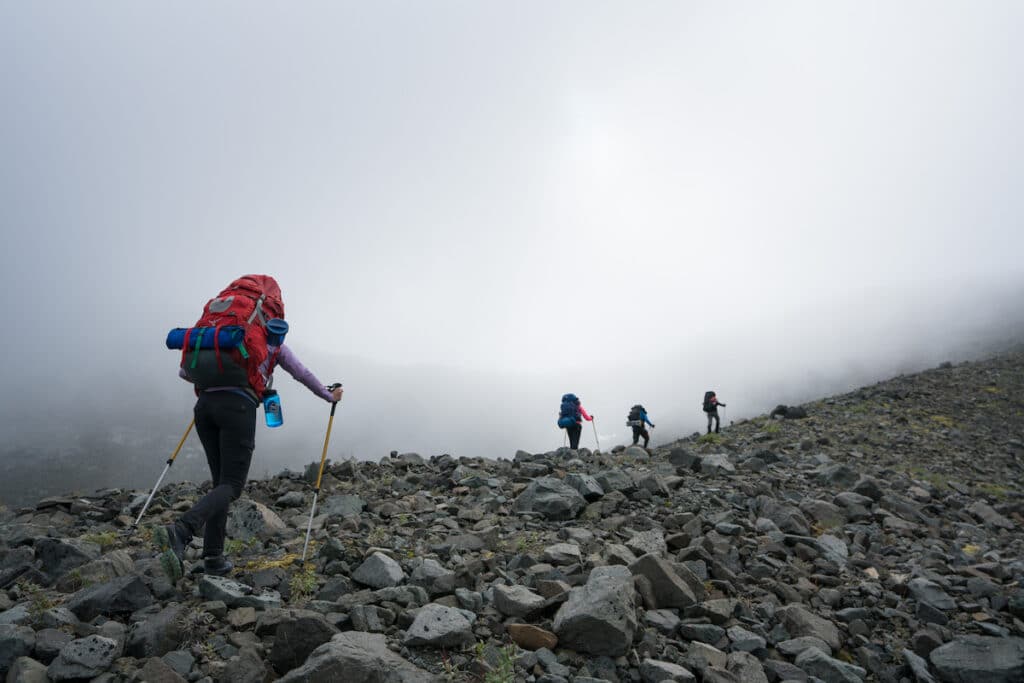
Trekking poles provide a lot of added stability when the trail gets slippery in wet weather
19. Pack a waterproof rain cover
It’s common for backpacks to come with a rain cover, but if yours doesn’t, you should get one. Look for a lightweight silicone-coated rain cover that will keep your gear dry inside your pack. If it’s really going to be a rainy hike, consider lining your day pack with a trash bag, too.
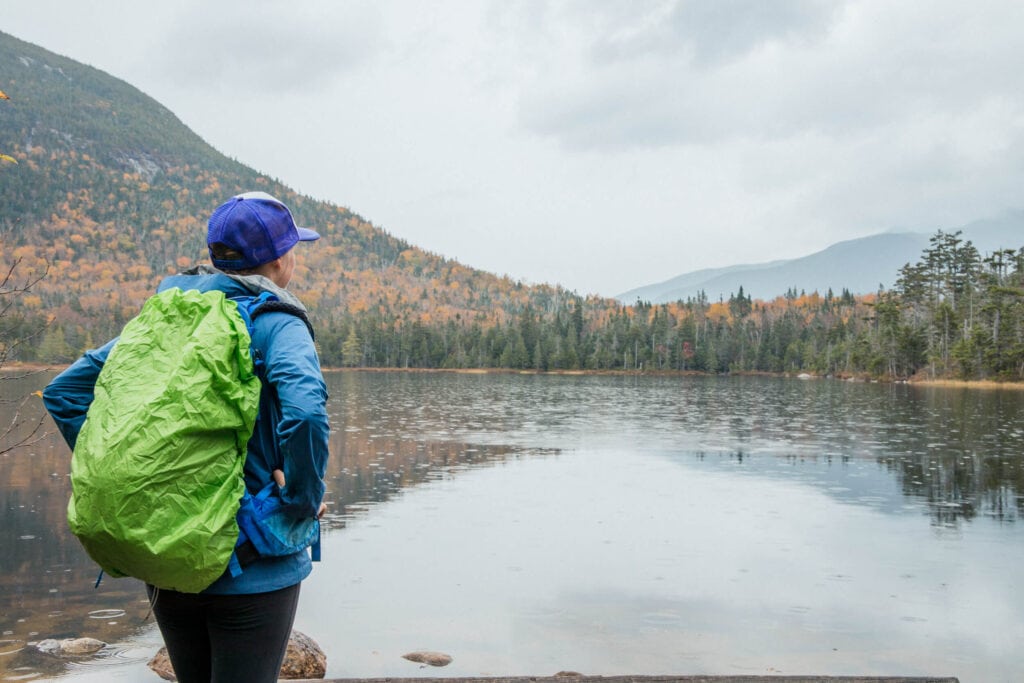
A right-sized rain cover will help keep your belongings dry
20. Bring a headlamp
Rainy days are often darker and more obscure than sunny days, so packing a headlamp can help you navigate the trail better and more safely. The Black Diamond Spot 400 Headlamp is waterproof and a great choice for hiking in the rain.
21. Pack a first-aid kit
Accidents are more likely to happen on rainy day hikes, so you’ll want to pack a lightweight and water-resistant first aid kit just in case.
Adventure Medical Kits
Adventure Medical Kits make lightweight first aid kits for day hikes and backpacking trips where the contents are packed inside of a waterproof pouch. This is important because your bandages will be no good if they are wet and won’t stick to you skin.
Mindset Tips for Hiking in the Rain
Enjoying a hike in the rain isn’t just about getting the right gear and choosing the right trail, it’s also about approaching your hike with a good mindset. I’ve found that even just small changes in my mindset can make a big difference in my overall experience.
21. Let go of the end goal
Oftentimes, hikers get into trouble when they’re too determined to make it to their final destination and “finish the hike.” When conditions worsen, it’s best to call it a day and head back.
One of the nice things about hiking in the rain is that you can slow down a bit. Instead of setting your sights on an end goal, take in the scenery. That way, if you end up having to turn around early, you’re content with what you did. Then, maybe go warm up with some tea or coffee and talk about the day (and your new-found love of hiking in the rain!).
22. Notice the upsides of rainy hikes
The more I’ve hiked in the rain, the more I’ve noticed the benefits. The biggest one is that rain wards off many hikers, so I enjoy having more of the trail to myself. Especially when I’m feeling overwhelmed, a rainy hike can provide just the peace and quiet I’m looking for.
It’s also hard to beat the earthy scent of rain. I love to soak up the sounds of rain hitting the trees and pattering against my rain jacket. It’s magical and makes the drawbacks of wet hair and sludgy trails a lot less frustrating.
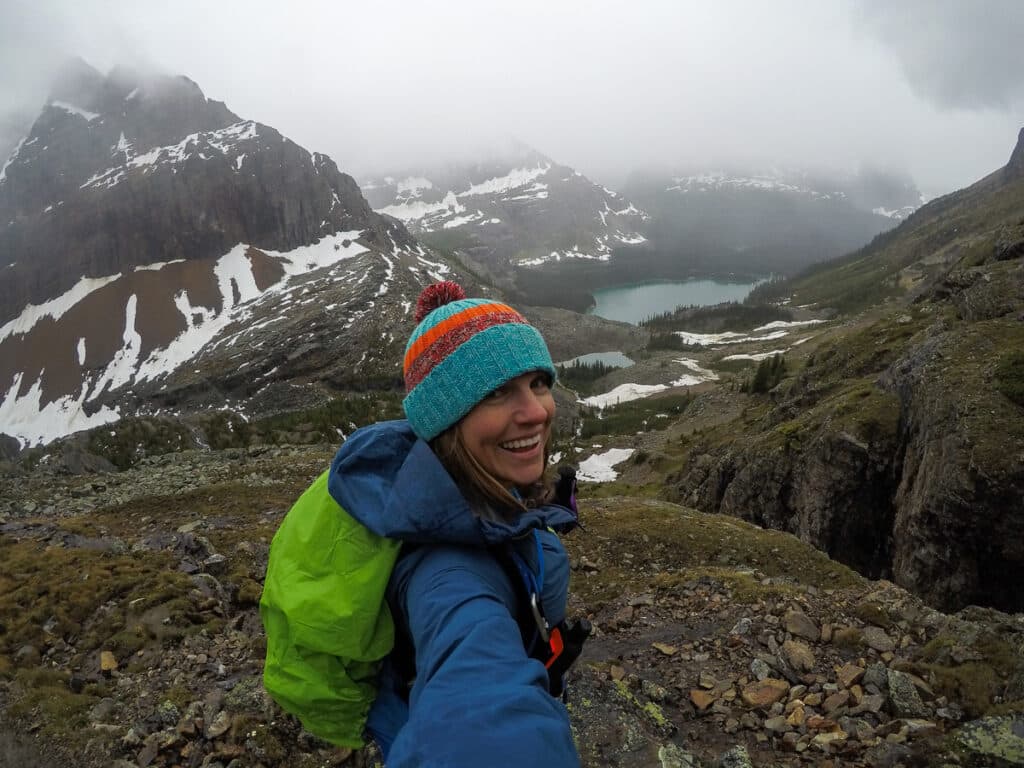
Rain means you might have the trail all to yourself
23. Choose to have a positive attitude toward hiking in the rain
I’ve been on both ends of the spectrum when it comes to whether or not to hike in the rain. While I was in New Zealand back in 2015, I let my trepidation about hiking in the rain stop me from doing so and I missed out on a good time.
Then, when I organized a group backpacking trip in Alaska it rained the whole trip. So, I didn’t have a choice other than to go with the flow. I noticed how the shift in my mindset about the situation allowed me to let go and enjoy my time, regardless of the weather. Plus, the misty, gray days make for some really nice hiking photos.
We can’t control what Mother Nature does, but we can control how we react to it. So, the next time you’re itching to get outside when you see a gray sky and rain coming – pack some water, snacks, and your rain jacket and go anyway! You might be one of the only people out on the trail, but I bet you’ll love it.

It rained for a good chunk of our backpacking trip in Alaska – but we still had fun!
Save this post to Pinterest
After reading these tips for hiking in the rain, I hope you feel confident and excited to go hiking on the next rainy day! Where do you like to hike in the rainy season? Let us know in the comments below.
The original version of this post was written by Taryn Eyton of Happiest Outdoors. It was more recently rewritten by the BFT team.
The post 23 Tips For Hiking In The Rain: How To Stay Dry and Comfortable appeared first on Bearfoot Theory.
https://bearfoottheory.com/5-tips-for-hiking-in-the-rain/
 CampingSurvivalistHuntingFishingExploringHikingPrivacy PolicyTerms And Conditions
CampingSurvivalistHuntingFishingExploringHikingPrivacy PolicyTerms And Conditions
